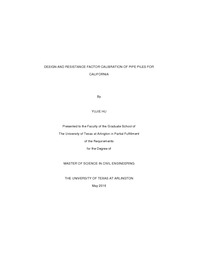
ATTENTION: The works hosted here are being migrated to a new repository that will consolidate resources, improve discoverability, and better show UTA's research impact on the global community. We will update authors as the migration progresses. Please see MavMatrix for more information.
Show simple item record
| dc.contributor.advisor | Yu, Xinbao | |
| dc.creator | Hu, Yujie | |
| dc.date.accessioned | 2017-03-23T18:06:03Z | |
| dc.date.available | 2017-03-23T18:06:03Z | |
| dc.date.created | 2016-05 | |
| dc.date.issued | 2016-05-11 | |
| dc.date.submitted | May 2016 | |
| dc.identifier.uri | http://hdl.handle.net/10106/26513 | |
| dc.description.abstract | Steel pipe piles, either open ended or close ended, are widely used in the state of California as bridge foundations due to high load bearing capacity, light weight, and outstanding workability. The design methods currently used by Caltrans were developed based on limited field data and are lack of field validations of the recent development of steel pipe piles. In this thesis study, 45 high quality steel pipe pile load tests performed in various soil conditions were collected from Caltrans’ load test data to evaluate available design methods and calibrate the resistance factors of selected design methods. A total of 26 static capacity prediction methods for pile skin and tip resistance were selected to predict total static pile capacity. The performance of the 26 design methods were systematically evaluated by comparing the estimated (Qc) and measured ultimate pile capacities (Qm). The evaluation was based on best fit line for predicted capacity Qc versus measured capacity Qm, mean and standard deviation for Qc/Qm values, cumulative probability of Qc/Qm values, and the histogram and lognormal distribution for Qc/Qm values. All the prediction methods were firstly ranked according to each single criterion and then ranked according to an overall rank index (RI) which considered the combination of all four single criterion.
Load and Resistance Factor Design (LRFD) calibration was performed on each calibration method by using Monte Carlo Simulation (MCS) method. Bias statistics was obtained by using mean and standard deviation of all measured bias and best fit lower tail of the measured bias. Monte Carlo simulation of 10,000 iterations was performed to calibrate resistance factors φ at target reliability index β of 2.33 for investigated methods. In addition, the relationship of resistance factors φ with various reliability index β has also been determined for best prediction method resulted from above mentioned assessment system. | |
| dc.format.mimetype | application/pdf | |
| dc.subject | Steel pipe piles | |
| dc.subject | Axial bearing capacity prediction | |
| dc.subject | Resistance factor calibration | |
| dc.title | Design and Resistance Factor Calibration of Pipe Piles in California | |
| dc.type | Thesis | |
| dc.degree.department | Civil Engineering | |
| dc.degree.name | Master of Science in Civil Engineering | |
| dc.date.updated | 2017-03-23T18:06:03Z | |
| thesis.degree.department | Civil Engineering | |
| thesis.degree.grantor | The University of Texas at Arlington | |
| thesis.degree.level | Masters | |
| thesis.degree.name | Master of Science in Civil Engineering | |
| dc.type.material | text | |
Files in this item
- Name:
- HU-THESIS-2016.pdf
- Size:
- 14.98Mb
- Format:
- PDF
This item appears in the following Collection(s)
Show simple item record


